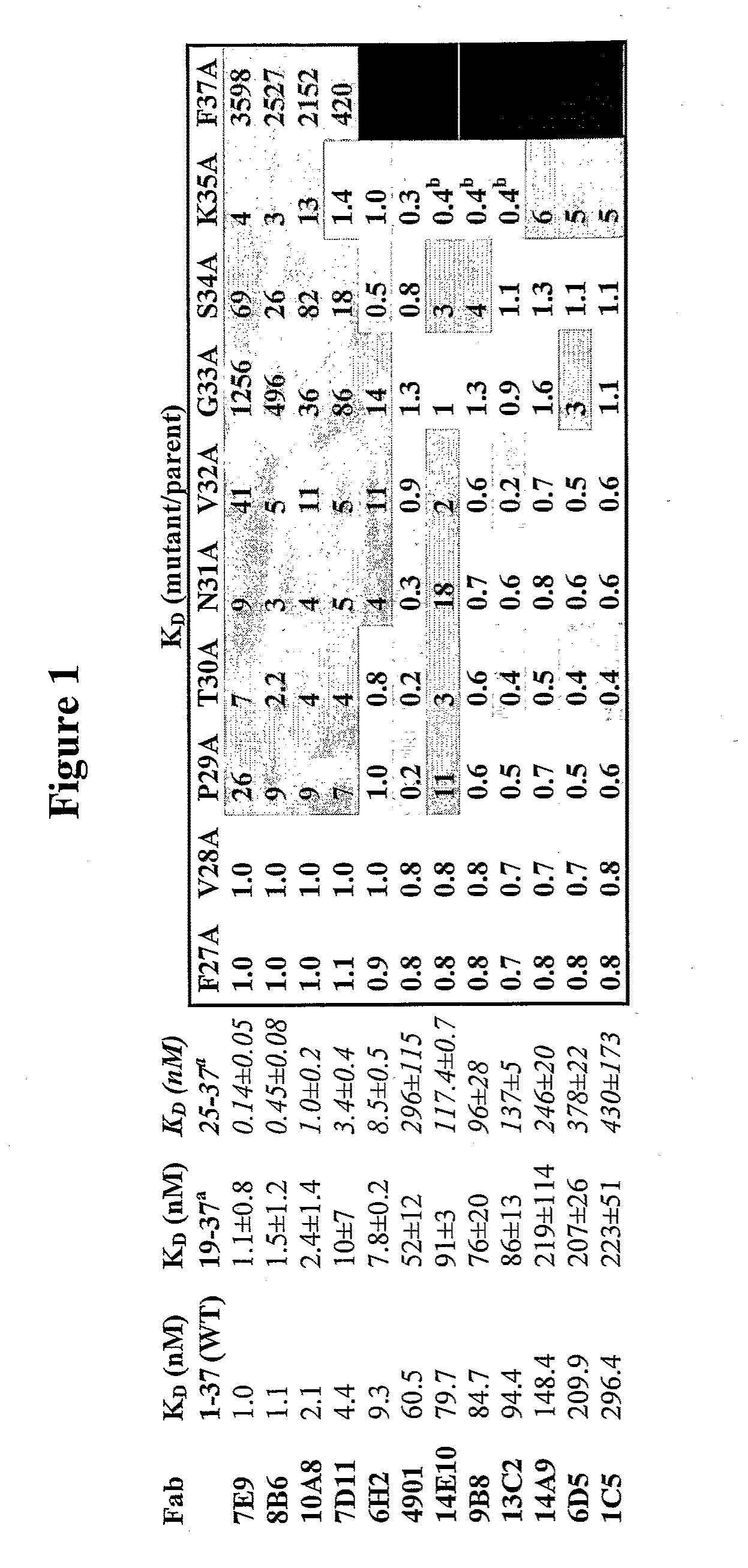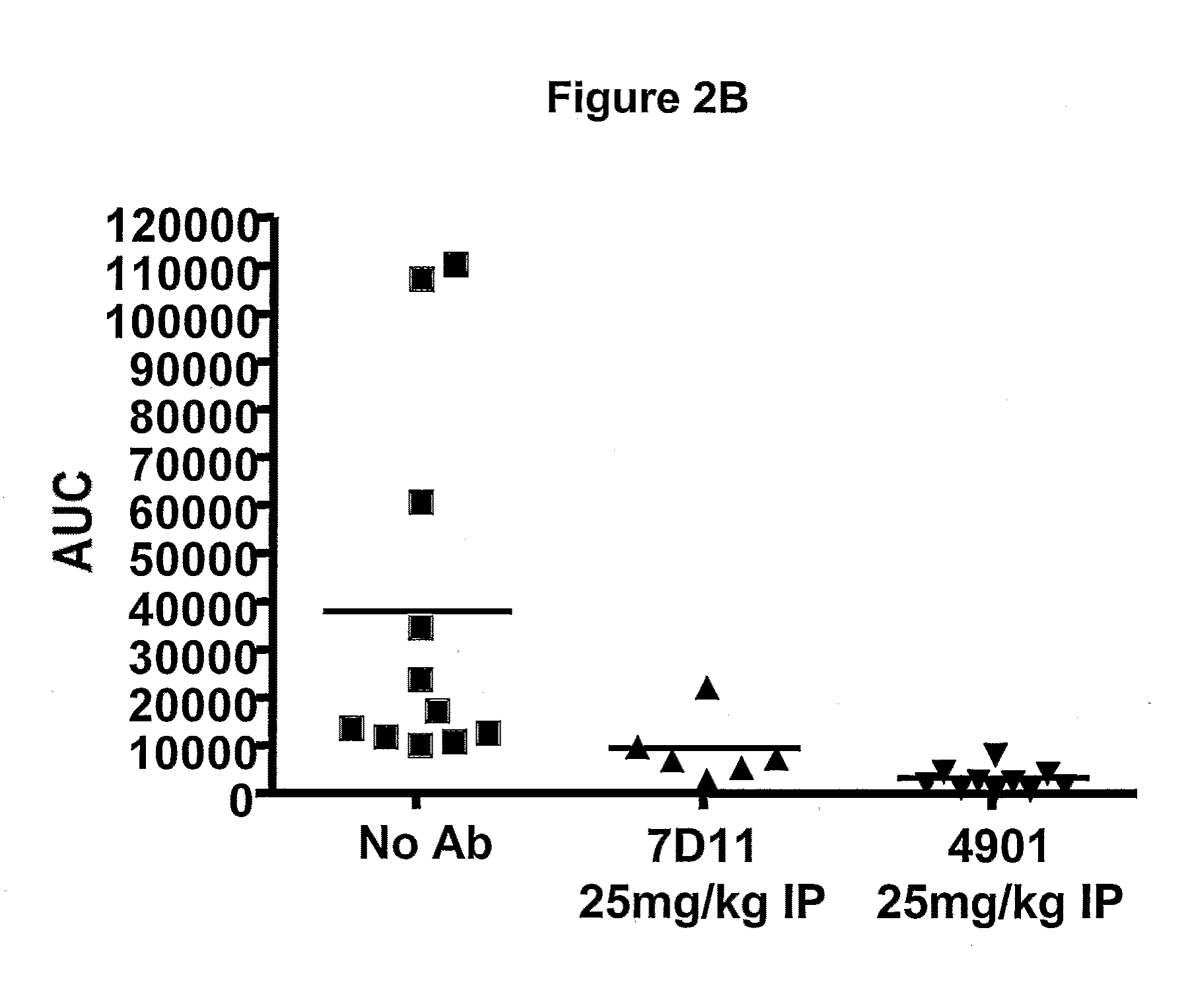Antagonist antibodies directed against calcitonin gene-related peptide and methods using same
a technology of calcitonin and anti-calcitonin, which is applied in the field of anti-calcitonin gene-related peptides, can solve the problems of significant discomfort and inconvenience, ineffectiveness, and inability to meet the needs of all women, and achieve the effects of reducing the incidence of hot flushes
- Summary
- Abstract
- Description
- Claims
- Application Information
AI Technical Summary
Benefits of technology
Problems solved by technology
Method used
Image
Examples
example 1
Generation and Characterization of Monoclonal Antibodies Directed Against CGRP
[0263]Generation of anti-CGRP antibodies. To generate anti-CGRP antibodies that have cross-species reactivity for rat and human CGRP, mice were immunized with 25-100 μg of human α-CGRP or β-CGRP conjugated to KLH in adjuvant (50 μl per footpad, 100 μl total per mouse) at various intervals. Immunization was generally performed as described in Geerligs H J et al., 1989, J. Immunol. Methods 124:95-102; Kenney J S et al., 1989, J. Immunol. Methods 121:157-166; and Wicher K et al., 1989, Int. Arch. Allergy Appl. Immunol. 89:128-135. Mice were first immunized with 50 μg of human α-CGRP or β-CGRP conjugated to KLH in CFA (complete Freund's adjuvant). After 21 days, mice were secondly immunized with 25 μg of human β-CGRP (for mice first immunized with human α-CGRP) or α-CGRP (for mice first immunized with human β-CGRP) conjugated to KLH in IFA (incomplete Freund's adjuvant). Twenty three days later after the secon...
example 2
Screening of Anti-CGRP Antagonist Antibodies Using In Vitro Assays
[0271]Murine anti-CGRP antibodies were further screened for antagonist activity in vitro using cell based cAMP activation assay and binding assay.
[0272]Antagonist activity measured by cAMP assay. Five microliters of human or rat α-CGRP (final concentration 50 nM) in the presence or absence of an anti-CGRP antibody (final concentration 1-3000 nM), or rat α-CGRP or human α-CGRP (final concentration 0.1 nM-10 μM; as a positive control for c-AMP activation) was dispensed into a 384-well plate (Nunc, Cat. No. 264657). Ten microliters of cells (human SK-N-MC if human α-CGRP is used, or rat L6 from ATCC if rat α-CGRP is used) in stimulation buffer (20 mM HEPES, pH 7.4, 146 mM NaCl, 5 mM KCl, 1 mM CaCl2, 1 mM MgCl2, and 500 uM 3-Isobutyl-1-methylxanthine (IBMX)) were added into the wells of the plate. The plate was incubated at room temperature for 30 min.
[0273]After the incubation, cAMP activation was performed using HitHunt...
example 3
Effect of Anti-CGRP Antagonist Antibodies on Skin Vasodilatation Induced by Stimulation of Rat Saphenous Nerve
[0276]To test antagonist activity of anti-CGRP antibodies, effect of the antibodies on skin vasodilatation by stimulation of rat saphenous nerve was tested using a rat model described previously. Escott et al., Br. J. Pharmacol. 110:772-776, 1993. In this rat model, electrical stimulation of saphenous nerve induces release of CGRP from nerve endings, resulting in an increase in skin blood flow. Blood flow in the foot skin of male Sprague Dawley rats (170-300 g, from Charles River Hollister) was measured after saphenous nerve stimulation. Rats were maintained under anesthesia with 2% isoflurane. Bretylium tosylate (30 mg / kg, administered i.v.) was given at the beginning of the experiment to minimize vasoconstriction due to the concomitant stimulation of sympathetic fibers of the saphenous nerve. Body temperature was maintained at 37° C. by the use of a rectal probe thermostat...
PUM
| Property | Measurement | Unit |
|---|---|---|
| temperature | aaaaa | aaaaa |
| temperature | aaaaa | aaaaa |
| pH | aaaaa | aaaaa |
Abstract
Description
Claims
Application Information
 Login to View More
Login to View More - R&D
- Intellectual Property
- Life Sciences
- Materials
- Tech Scout
- Unparalleled Data Quality
- Higher Quality Content
- 60% Fewer Hallucinations
Browse by: Latest US Patents, China's latest patents, Technical Efficacy Thesaurus, Application Domain, Technology Topic, Popular Technical Reports.
© 2025 PatSnap. All rights reserved.Legal|Privacy policy|Modern Slavery Act Transparency Statement|Sitemap|About US| Contact US: help@patsnap.com



